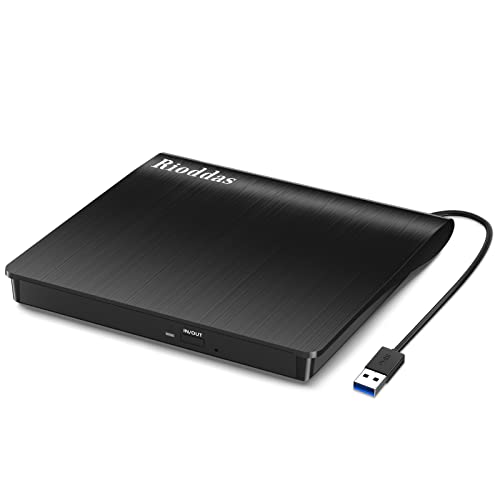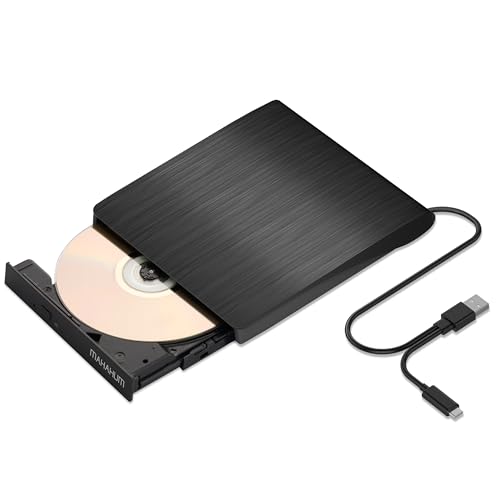The Best DVD Drives

To help you find the perfect dvd drive, we continuously put forth the effort to update and expand our list of recommendable dvd drives. Our team collects, edits and publishes new information, in order to present it to you in an accurate, significant and neatly arranged way.
Our Picks
8 More DVD Drive Alternatives
Table of Contents
Buying Guide
DVD Drive Buying Guide
As removable flash storage devices have become larger and cheaper -- and more people have begun to download games, music and movies online -- most computer owners have begun to find optical drives redundant. It has become particularly common for companies to sell notebook computers without DVD drives because omitting on optical drive makes it possible to design a thinner and lighter computer.
Although few computers include them today, DVD drives still have plenty of uses. You might have an existing collection of movies or computer software that you'd like to continue enjoying. Recordable DVDs also give you an affordable way to back up your most important data or create free space on your computer's hard drive.
Even if you only need to use it occasionally, a DVD drive is one of the least expensive upgrades that you can buy for your computer. In this guide, we'll provide some pointers that can help you pick the right one.
Internal or External?
Benefits of Internal Drives
If you have a desktop computer, your computer most likely has several upgrade bays in the front. You can use one of those bays for installing an internal DVD drive that will become a semi-permanent part of your computer. Internal DVD drives typically reach higher top speeds than external drives. They're also slightly more reliable. If an external DVD drive falls off of the desk while recording a disc -- or its cable is removed -- the disc will be ruined. The chance of an internal DVD drive suffering physical damage during recording is extremely slim. Since internal drives do not require plastic enclosures for beautification, they typically cost less than external drives.Benefits of External Drives
If you have a notebook, your computer probably doesn't have an upgrade bay for optical drives. In that case, buying an external DVD drive is the only logical choice. Even if you have a desktop computer, an external drive may be the right choice for you because external drives are easy to move from one computer to another as needed. If you have little technical knowledge or are simply nervous about disassembling your computer, an external drive is perfect because you can install it by simply connecting it to one of your computer's peripheral ports. Any reasonably modern computer will recognize the drive, and you can begin using it right away.Reader or Burner?
DVD drives have two primarily capabilities: They can read discs, and they can burn them. The term "burn" refers to writing data on a disc. A DVD burner can read and write data, but a DVD writer can only read discs. Today, companies produce DVD burners so inexpensively that you can find them for sale at retail prices under $15. Since DVD burners are so inexpensive, there's little reason to produce DVD drives that can only read discs. Nearly every DVD drive on the market is a DVD burner. If you consider purchasing a used drive, though, you should confirm its capabilities before buying it.
Media Compatibility
There are many different standards for CD and DVD discs. Most DVD drives support all of the different standards, but it's wise to confirm support before buying a DVD drive if you need to read or burn a specific type of disc. Some of the most common types of discs include:
- CD: CD that supports reading only.
- CD-R: Recordable CD.
- CD-RW: Recordable CD that you can burn and erase more than once.
- DVD: DVD that supports reading only.
- DVD-R and DVD+R: Recordable DVD.
- DVD-RW and DVD+RW: Recordable DVD that you can burn and erase more than once.
- DVD-R DL and DVD+R DL: Dual-layer recordable DVD that holds twice as much data as a single-layer DVD.
- DVD-RW DL and DVD+RW DL: Dual-layer recordable DVD that you can burn and erase more than once.
- M-DISC: Archival recordable disc theoretically capable of storing data safely for hundreds of years.
NOTE: DVD-R and DVD+R are competing standards for recordable DVDs. Pioneer created the "-R" format. Sony and Philips jointly developed the "+R" format. Most DVD drives and read and write both types of discs.
Speed
When you shop for a DVD drive, you'll see ratings that express the drive's speed when reading and writing CDs and DVDs. The ratings express the speeds as multiples, such as "52X." When reading or writing CDs, the "1X" speed is approximately 1.22 Mbits/sec. When reading or writing DVDs, the "1X" speed is about 11 Mbits/sec. You can generally expect a DVD drive's read speeds to be faster than its write speeds. In order to write a disc at a given speed, the disc and drive must both support that speed. If a disc doesn't support a write speed, errors may result.
Buffer Size
When you burn discs on your computer, you'll likely want to do other things at the same time. You might want to listen to music or browse the web, for example. Occasionally, your activities may interrupt the data that streams from the computer's hard drive to the DVD drive. The buffer in a DVD drive is a memory chip that allows the drive to continue writing to the disc when the computer's hard drive is busy. Without a buffer, any interruption in the data stream would ruin the disc. The larger a DVD drive's buffer is, the more reliable the drive is when burning discs.Included Extras
When you buy a DVD drive, you can choose to buy a retail boxed drive or a OEM drive. An OEM drive arrives in a plain box and typically costs less. A retail boxed drive may include several extras that can enhance your experience. An external drive may include a USB cable. An internal drive may include a data cable, a power cable and mounting screws. A retail boxed DVD drive may also include disc authoring software.
Connection Type
Whether you buy an internal or external DVD drive, you'll have a few different types of connections from which to choose. The most common connection for internal DVD drives is SATA, and the most common connection for external DVD drives is USB. If your computer is less than 10 years old, you can safely assume that it will support either standard. If you have an older desktop computer, you should look inside it before buying a DVD drive. If your computer's hard drive connects to the motherboard using a thin, flat ribbon cable, your computer may not support SATA DVD drives. You should look for an ATA DVD drive instead.
Top Rated DVD Drives
If you're looking into finding the best rated dvd drive, you should probable check out the Rioddas External Drive. We looked at various sources of reviews and found this one to have the best mix between review count and average rating stars.
The Lowest Price We Could Find
Often, going for the best price is a simple but good option. With a price of $13.19 (last checked this morning), we do not list any other dvd drive cheaper than the MAHAHUM External +/-RW Drive. Just remember that it's not always the best option to go for the cheapest one.
The DVD Drive With the Most Reviews
With at least 3459 reviews and counting, the LG GP65NB60 8X USB 2.0 Super Multi Ultra Slim Portable Writer Drive might be another option to consider. This large amount of reviews signalizes that many people are using it, with most of them beeing satisfied.
High Quality DVD Drives
It's quite rare that the saying "You get what you pay for" turns out incorrect. If you have the money on the sideline, feel free to choose the most expensive item from our list: The ASUS ZenDrive currently sells for $39.99.
The DVD Drive With the Most Clicks
If you trust us and our users, feel free to check out the Dell USB Slim +/. Our statistics say that it is the most favorite DVD Drive from the list above.
Our Bestseller
If you're still undecided, I would recommend that you go with the masses and choose the top selling dvd drive: The Dell USB Slim +/ is the hottest bestseller in this category right now.
DVD Drive Reviews
Further Reading on DVD Drives
Research
DVD players, to hack, and their factory codes. Older DVD drives use RPC-1 ("Regional Playback Control") firmware, which means the drive allows DVDs from
using the DVD -Video specification require a DVD drive and an MPEG-2 decoder (e. g., a DVD player, or a computer DVD drive with a software DVD player).
DVD ±R (also DVD +/-R, or " DVD plus/dash R") is not a separate DVD format, but rather is a shorthand term for a DVD drive that can accept both of the common
reading and writing process may not happen at a steady speed. CD drives and many early DVD drives stored data with constant linear velocity, so that the data
drives, a 5.25″-wide square. Half-height drive bays are 1.625″ high by 5.75″ wide (41.3 mm × 146.1 mm), and are the standard housing for CD and DVD drives
Abstract A space saving CD-ROM/ DVD drive mechanism used with an electronic device, such as a portable notebook computer, a handheld global positioning system (GPS) or etc. The space saving CD-ROM/ DVD drive mechanism comprises an optical head and a spindle …
… Keys can be passed from a DVD drive to a descrambler over a PC bus using a secure handshake protocol (different from 5C). The purpose of CSS is twofold … 4(b) it is in the DVD drive. Each of these solutions has its advantages and its disadvantages …
… single sided single layered and has a total capacity of 2.6 GB. To control each individual DVD library, a command is issued to move the DVD media tray from the shelf by the picker and to insert it into the DVD drive … To provide reliability, the 6th DVD drive is used as parity drive …
Useful Videos
For more in-depth reviews and information regarding the best external DVD drives check out tenpire.com Most laptops no longer ...
Comments
About this Article
It was last updated on 2026-01-11 08:08:13 and has been viewed 6047 times.




